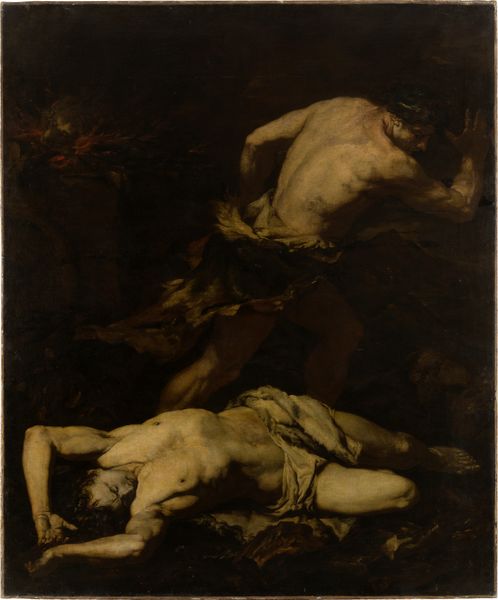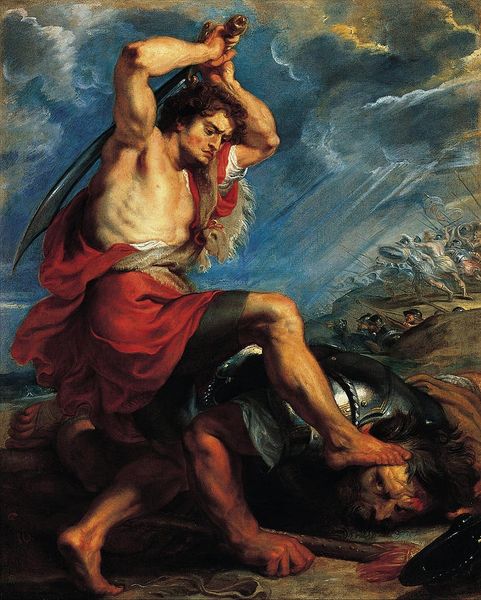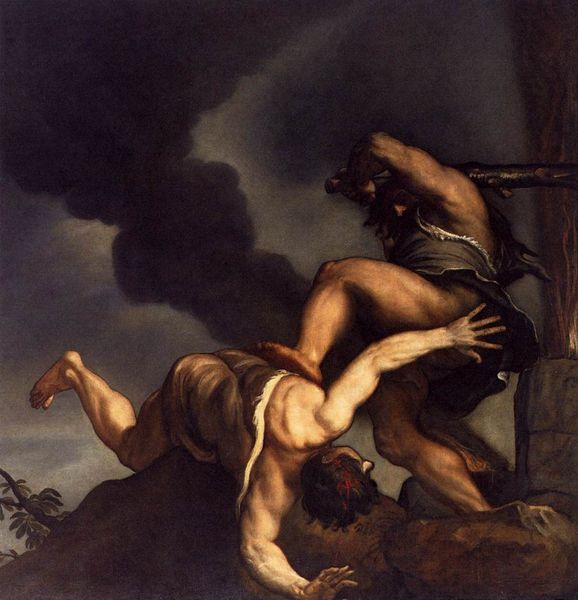
painting, oil-paint
#
painting
#
oil-paint
#
mannerism
#
figuration
#
oil painting
#
roman-mythology
#
mythology
#
history-painting
#
italian-renaissance
#
nude
#
realism
Dimensions: 237 x 216 cm
Copyright: Public domain
Curator: Titian's "Sisyphus," dating back to 1549, now resides at the Museo del Prado. He painted this poignant depiction in oil, capturing a very tragic scene, wouldn’t you say? Editor: Absolutely, that figure, burdened and strained, feels eternally caught. The muscularity, though classically rendered, speaks to something raw and immediate. A very fleshy figure straining against such harsh jaggedness, as though existence itself grinds. Curator: Titian was diving into classical mythology here, and Sisyphus' tale—the king doomed to eternally roll a boulder uphill, only to have it fall back down—becomes an exploration of human futility. Notice the dark, swirling background—it's pure torment, wouldn’t you agree? Editor: Precisely. And Titian uses that chiaroscuro, that play of light and shadow, to really highlight the emotional weight. The almost serpentine figures at the base? Those are infernal creatures. They add another layer of the torturous eternity to the myth. Curator: As if the rock wasn't enough, there’s serpents literally at his feet. Speaking to an overall fear for an eternal recurrence of a life spent with such burden. It is rather poetic in its pessimism, if such a thing could be appreciated. Editor: What’s fascinating is how universal the symbolism is. We all, on some level, identify with Sisyphus—the endless tasks, the projects that never truly conclude, the weight of living itself. And here’s Titian making visible, and quite physical, the soul's unending labor. Curator: Right? It transcends the myth itself. I always wonder about Titian's headspace while crafting this piece. Was he merely illustrating a well-known legend, or was there a deeper personal resonance at play? What's also striking is the physicality of the act that he depicts. Editor: Definitely resonates. Even with the historical distance, there’s something intensely personal, almost existential. To give the unseen weight, the soul-crushing defeat, a very tangible form is such a feat. It lingers because the emotion feels genuinely, horribly familiar. Curator: Indeed. Looking at it again, I feel Sisyphus is as contemporary today as he was when Titian first brushed him into existence. A timeless mirror reflecting the absurdity of our endeavors. Editor: And that's the enduring power of icons—they echo through the ages. A constant visual reminder that some burdens we are all cursed to shoulder. Thank you for helping to share insights with me about "Sisyphus."
Comments
No comments
Be the first to comment and join the conversation on the ultimate creative platform.













